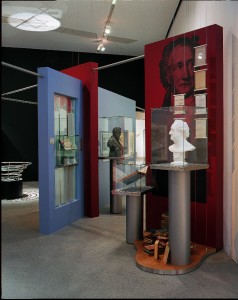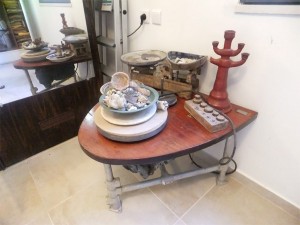When you do a search of our library catalog for Goethe you could get this idea: 70 hits for works by or about the German poet (by contrast, Schiller only gets 16). And until a few years ago the impressive 1867 Cotta’schen edition of Goethe appeared in our permanent exhibition. Many people used to ask the visitor’s desk: “Was Goethe Jewish?” No, he wasn’t. But for many Jews he was the paragon of German culture, and his works symbolized membership in the German educated middle-class.

Former Goethe installation in the permanent exhibition
© Jewish Museum Berlin, photo: Marion Roßner
A few months ago, the Richard M. Meyer Foundation gave us more than 100 books by and about Richard M. Meyer himself. The son of a banker, art collector, and man of letters was a Goethe scholar. Meyer never acquired a proper professorship, but his 1895 biography of Goethe won awards and was published again and again – as a single volume, in multiple volumes, as a people’s edition and a reserved edition. According to the biography, Goethe saw “nationalities merely as transitional forms” (Volksausgabe [People’s Edition] 1913, p. 352). Statements like this illustrate the dilemma of German-Jewish assimilation during that period. If a Jewish reader of Goethe placed the poet’s cosmopolitanism in the foreground, he exposed himself to the accusation of misunderstanding the German essence of his writings. But when he explicitly recognized just this quality in Goethe’s language, his very right to have a say was contested. → continue reading
An Appeal for Recognition and Dignity
“We used to throw stones at her – we thought she was a witch.” With these words, a former resident of Rishon LeZion ruefully told me of her childhood encounters with the sculptor and doll maker, Edith Samuel. Edith wore her long, dark, European skirts under the searing Middle Eastern sun and suffered from a physical deformity. The daughter of a liberal German rabbi, Edith and her sister Eva were both artists who left their home city of Essen in the 1930s and immigrated to Palestine.

The pottery wheel belonging to Paula Ahronson, Eva Samuel’s business partner, is preserved in private hands and untouched since her death in 1998
© Jewish Museum Berlin, photo: Michal Friedlander
The Samuel sisters worked long hours, struggled to earn a living and did not gain the recognition that they deserved, during their lifetimes. The exhibition “Tonalities” at the Jewish Museum Berlin aims to bring forgotten women artists back into the public arena. It presents Eva Samuel’s works and that of other women ceramicists who were forced to leave Germany after 1933.
My search for transplanted German, Jewish women in the applied arts began many years prior to my encounter with the Samuel sisters. It was Emmy Roth who first captured my attention. Born in 1885, Roth was an exceptionally talented and internationally successful silversmith, who worked in Berlin. She immigrated to Palestine and fell into obscurity, ultimately taking her own life in 1942. Her male refugee colleagues, Ludwig Wolpert and David Gumbel, were appointed to teach metalwork at the Jerusalem New Bezalel School of Art in the late 1930s. They are feted in Israel today, whereas Roth is still completely unknown there. → continue reading
Why Lilith Fascinates Our Visitors

View of our permanent exhibition
© Jewish Museum Berlin, photo: Jens Ziehe
One of the tours of the permanent exhibition that I offer regularly is on the subject of women in Judaism. Visitors interested in this topic are usually women’s groups and people already familiar with the essentials of Judaism and Jewish history. I enjoy the lively discussions I have with participants of this tour. When we talk about the life of Glikl of Hameln, Dorothea Schlegel, Albertine Mendelssohn-Bartholdy, and Else Lasker-Schüler, or about Lilith and Eve, we’re also discussing women’s rights – and that means our own rights!
People have heard a wide variety of things about Lilith: “Doesn’t she appear in Goethe’s Faust?” “Lilith is important for fortune telling with cards.” “Adam’s first wife, before Eve.” Some think of Lilith as a threatening ghostly figure, and others named their daughter after her, since she also represents self-determination, independence, unbridled ferocity, and joyous sensuality. Her model of life contrasts with the traditional image of women – in fact, she is Eve’s foil. No wonder that the name Lilith is known above all in feminist circles. → continue reading


